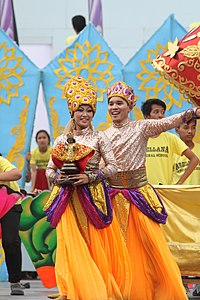Cebuano people
 Cebuano men who served as guards in the early 20th century during theAmerican period. | |
| Total population | |
|---|---|
| 8,683,525(2020)[1] | |
| Regions with significant populations | |
(Central Visayas,Negros Oriental,Masbate,western parts ofEastern Visayas,large parts ofMindanao) Worldwide | |
| Languages | |
| Cebuano,Filipino,English | |
| Religion | |
| PredominantlyRoman Catholicism. Minority others:Aglipayan,Protestantism,Islam,Buddhism,Hinduism,Taoism | |
| Related ethnic groups | |
| Boholano,Ilonggo,Waray,otherVisayans otherAustronesian peoples |
TheCebuano people(Cebuano:Mga Sugbuanon) are the largest subgroup of the largerethnolinguistic groupVisayans,who constitute the largestFilipino ethnolinguistic groupin the country. They originated in the province ofCebuin theregionofCentral Visayas,but then later spread out to other places in the Philippines, such asSiquijor,Bohol,Negros Oriental,southwesternLeyte,westernSamar,Masbate,and large parts ofMindanao.It may also refer to theethnic groupwho speak the same language as their native tongue in different parts of the archipelago. The termCebuanoalso refers to thedemonymof permanent residents in Cebu island regardless of ethnicity.
History
[edit]
The earliest European record of Cebuanos was byAntonio Pigafettaof theMagellan expedition.He provided some descriptions of their customs as well as samples of theCebuano language.[2][3]Ferdinand Magellanwas killed in Cebu during theBattle of Mactanagainst the forces ofLapulapu.[4][5]
Later early Spanish colonists referred to the Cebuanos (and otherVisayans) as thepintados( "the painted ones" ), due to their widespread practice of tattooing to record battle exploits.[5]
Culture and festivities
[edit]
The majority of Cebuanos areRoman Catholic,with many in rural areas synchronizing Catholicism with indigenous Bisayan folk religion. A minority of Cebuanos (specifically those inMindanao) areMuslim(due to their contact with the Moro people), or in mixed Chinese-Cebuano families, incorporate Catholic beliefs with aspects ofBuddhismorTaoism.[6]A recent genetic study found 10-20% of Cebuano ancestry is attributable toSouth Asian(Indian) descent,[7]dated to a time when Precolonial Cebu practiced Hinduism.[8]Meanwhile, according to Spanish era tribute-censuses,Spanish-Filipinoscompose 2.17% of the Cebuano people's population.[9]: 113
Among the island's notable festivities are theSinulog[10]festival, which is a mixture of Christian and native cultural elements, celebrated annually every third week of January.
Language
[edit]TheCebuano languageis spoken by more than twenty million people in the Philippines and is the most widely spoken of theVisayan languages.Most speakers of Cebuano are found in Cebu, Bohol, Siquijor, southeastern Masbate,Biliran,Western and Southern Leyte, easternNegrosand most of Mindanao exceptBangsamoro Autonomous Region in Muslim Mindanao.
See also
[edit]- Demographics of the Philippines
- Ethnic groups in the Philippines
- Cebu
- Cebuano language
- Rajahnate of Cebu
- Tagalog people
- Kapampangan people
- Ilocano people
- Ivatan people
- Igorot people
- Pangasinan people
- Bicolano people
- Negrito
- Visayan people
- Lumad
- Moro people
References
[edit]- ^"Ethnicity in the Philippines (2020 Census of Population and Housing)".Philippine Statistics Authority.RetrievedJuly 4,2023.
- ^Donald F. Lach(1994).Asia in the Making of Europe, Volume I: The Century of Discovery.University of Chicago Press. pp. 175, 635–638.ISBN9780226467320.
- ^Sebastian Sta. Cruz Serag (1997).The Remnants of the Great Ilonggo Nation.Rex Bookstore, Inc. p. 95.ISBN9789712321429.
- ^Blair, Emma Helen (August 25, 2004).The Philippine Islands.The Project Gutenberg EBook of The Philippine Islands, 1493-1803, Volume II, 1521-1569, by Emma Helen Blair. p. 126, Volume II. [EBook #13280].
- ^abPaul A. Rodell (2002).Culture and Customs of the Philippines.Greenwood Publishing Group. p. 50.ISBN9780313304156.
- ^"Culture and Lifestyle".Cebu Province official website.Archived fromthe originalon 2018-08-01.Retrieved2018-11-13.
- ^Delfin, F., Min-Shan Ko, A., Li, M., Gunnarsdóttir, E. D., Tabbada, K. A., Salvador, J. M., Calacal, G. C., Sagum, M. S., Datar, F. A., Padilla, S. G., De Ungria, M. C. A., & Stoneking, M. (2014). Complete mtDNA genomes of Filipino ethnolinguistic groups: a melting pot of recent and ancient lineages in the Asia-Pacific region. European Journal of Human Genetics, 22(2), 228–237.
- ^Kuizon, Jose G. (1962).The Sanskrit loan-words in Cebuano-Bisayan language and the Indian elements to Cebuano-Bisayan culture(Thesis). University of San Carlos, Cebu.OCLC3061923.
- ^ESTADISMO DE LAS ISLAS FILIPINAS TOMO SEGUNDO By Joaquín Martínez de Zúñiga (Original Spanish)
- ^"Cebu Philippines Festivals, Fiestas and Cultural Event".eTravel Pilipinas-Discover the Wonders of Island Paradise.Archived from the original on 2015-09-11.Retrieved2009-11-18.
{{cite web}}:CS1 maint: unfit URL (link)
